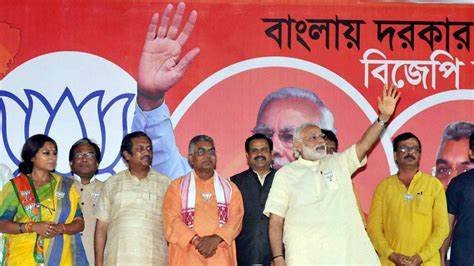BJP Rises From 3 to 80 in west bengal, Decimates left, congress, Emerges As Principal Opposition & Leaves Mamata In Tenterhooks For Her Nandigram Seat


Though Mamata’s TMC managed to win with 209 seats and BJP with 80 going by the counting trends till 4.20 pm, this election has changed many a paradigms in the politics and cultural space of West Bengal.
The BJP has wiped out whatever was left of the Left parties in Bengal as it emerged as the principal and only opposition to the formidable figure of Mamata Banerjee in West Bengal. In the battle of ideologies, now there are only two groups – one the TMC, which panders Islamo-Fascist ideology pushing West Bengal to become Greater Bangladesh and the other represented by the BJP, which is singularly opposing the rise of Islamism in Bengal.
The political honchos in West Bengal who were habituated to gladly reciting Islamic slogans in the name of secularism, were forced to change their ways when we saw the Chandi Paath being recited by an unnerved Mamata who was being perceived as an anti-Hindu leader.
Mamata is now struggling to win her seat from Nandigram as she faces stiff opposition from her own protégé turned rival candidate, Suvendhu Adhikari from BJP. As at 4.30 pm, Suvendhu Adhikari was leading by six votes as the last round of counting in underway. Earlier, Adhikari was leading by 9,000 votes which was neutralised as the rounds of counting progressed. In the seventeenth round of counting Mamata was leading by a slim margin by 1,200 votes which was ultimately neutralised by Suvendhu in the last round by trouncing Mamata by a lead of 1400 votes and sealing the seat for BJP.
All said and done, it would be difficult for Mamata Banerjee to restrict Hindus from restraining Hindus from immersing Durga idols and jailing people for raising the slogan of Jai Shri Ram.
Perhaps BJP’s chances at the hustings would have improved if it had pushed the Hindutva agenda full throttle, considering Hindu community as a whole unit without concentrating on particular communities like the Matuas and the Dalits in Jhagram-Jangalmahal area.
The Muslim concentration in Assam is much greater than in West Bengal, yet BJP managed to win the elections handsomely in Assam. As the BJP led by Himanta Biswa Sarma made it a straight fight between the native Assamese Hindu tradition and culture verses the growing Muslim demography in Assam represented by Badruddin Ajmal’s AIUDF imposing an Islamist Bangladeshi culture in the State of Assam.
So, even the anti-CAA movement in Assam, could not effect the outcome as the BJP there successfully convinced the Assamese Hindus that separate political solutions would be chalked out for Bengali Hindus while keeping intact the Assamese culture and nativity. They could impress on the electorate that one has to fight the external enemy which wants to decimate Hindus in Assam as one united community burying internal differences.
The Bengal experiment is half job done, BJP needs to openly push a Hindutva agenda, as Hindutva is not a mere religious identity, it encompasses within itself nursing nationalistic sentiments, economic development and culutral revivalism.
Last but not the least, importing turncoats into the party, with no ideological leanings to Hindutva and giving them party tickets in huge numbers has proved to be counter productive in West Bengal. The turncoats of West Bengal did not adopt Hindutva ideology as Himanta Biswa Sarma did in Assam, moreover many of them were involved in attacking RSS and BJP activists in the past and that did not go down well with the diehard committed grassroot members of the BJP-RSS Sangh Pariwar in West Bengal.
Now, the centre under the leadership of PM Modi and HM Amit Shah should take care of the safety of their workers and electorate in West Bengal who worked and voted for the party and are bound to be physically targeted by the TMC goons.
The BJP should introspect its performance in Bengal and look at it as a half won battle, which needs an overhaul of strategy to win the final war of Islamo-Commie Fascism culture in West Bengal. It is also the responsibility of BJP as the party in Centre and the principal opposition party in West Bengal to not let Bengal become Greater Bangladesh.
DISCLAIMER: The author is solely responsible for the views expressed in this article. The author carries the responsibility for citing and/or licensing of images utilized within the text.
